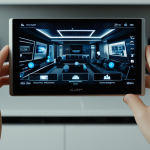Overview of Technology in Home Environments
The evolution of technological advancements in home environments has been substantial over the years. From simple household appliances to the intricate systems of today, homes have increasingly incorporated smart home technology. This includes devices that communicate over networks, such as intelligent thermostats and security systems, allowing for enhanced control and customization.
At the core of modern smart homes lies the IoT integration, which enables devices to work in harmony, exchanging data and performing functions based on user preferences. Key components of these systems include connectivity through hubs or voice assistants, sensors, and automated controls.
Also to read : The Secrets of Sustainable Home Living: How Can You Create an Eco-Friendly Household?
By integrating smart technology into daily life, homeowners can experience a range of benefits. Enhanced convenience, energy efficiency, and improved security are notable advantages. These systems can significantly streamline daily routines and create more efficient living spaces. This progress in home technology continues to shape the way we manage our living environments, emphasizing the growing importance of adaptability and forward-thinking designs.
Smart Home Devices and Automation
Embracing the world of smart devices and home automation fundamentally transforms everyday living. These technologies offer streamlined solutions to enhance convenience and comfort. With such evolution, smart homes can cater to individual preferences and dynamic requirements in unique ways.
Additional reading : What Simple Changes Can Transform Your UK Home into a Haven?
Types of Smart Devices
Smart devices are diverse and can serve many functions. Key types include:
- Voice assistants like Amazon Alexa or Google Assistant, which perform tasks from setting reminders to controlling other devices through voice commands.
- Smart lighting that can be adjusted in intensity and color remotely, often customizable to sync with specific events or routines.
- Security systems equipped with smart surveillance cameras offering remote monitoring and advanced motion detection features.
These devices represent the backbone of smart homes, allowing seamless integration and greater control.
Benefits of Home Automation
The primary benefit of home automation is the ease it brings to managing daily tasks. It allows users to:
- Automate lighting schedules, ensuring lights are off when not needed, thereby saving energy.
- Manage home climates via smart thermostats, optimizing heating and cooling efficiently.
- Enhance security through automated locks and alarm systems.
This automation not only offers convenience but also contributes to energy and cost efficiency.
Examples of Smart Home Devices in Use
In practical scenarios, smart home devices have proven their worth. Voice assistants are being used to maintain schedules and reminders hands-free. Smart lighting systems adjust automatically depending on the time of day or activity, enhancing ambiance without user intervention. Security systems now include doorbell cameras providing live feeds and alerts directly to smartphones. Such applications illustrate the tangible benefits and growing adoption of smart technologies in modern living spaces.
The Role of IoT in Home Living
The Internet of Things (IoT) revolutionizes home environments by seamlessly connecting devices, enabling them to communicate and collaborate. This network of connected devices optimizes the functionality of appliances and systems, driving data communication that enhances daily living.
IoT Applications in Homes
At the core of IoT applications in homes is the ability to improve energy efficiency and sustainability. For instance, smart thermostats leverage real-time data to adjust temperatures based on occupancy, significantly reducing energy usage. Similarly, smart meters track energy consumption patterns and suggest adjustments to minimize waste, contributing to sustainability.
Real-Life Examples
Consider a scenario where smart refrigerators track food usage and expiration dates, notifying users via smartphone alerts. Such data communication ensures that perishable items are used efficiently, cutting down on food waste. Another example is smart irrigation systems that analyze weather forecasts and soil moisture levels to optimize water use, promoting eco-friendly practices.
The Internet of Things transforms traditional living spaces into intelligent environments, which are not only sustainable but also more convenient and efficient. As technology continues to evolve, the role of IoT in home living will undoubtedly expand, offering even more innovative solutions for household management.
Security Innovations in Smart Homes
In today’s dynamic environment, home security stands at the forefront of technological advancements. By embracing cutting-edge safety technology, homeowners can significantly bolster their protective measures, ensuring peace of mind.
Advancements in Home Security Technologies
Recent developments have revolutionized how we manage safety in our homes. Modern surveillance systems now offer significant enhancements, including:
- Smart cameras with facial recognition, detecting known individuals and alerting homeowners of unfamiliar faces.
- Advanced motion sensors that integrate with alarms to provide real-time updates and immediate responses.
These technological strides not only advance security but also personalize it, making it more intuitive and responsive.
Case Studies Illustrating Enhanced Security Measures
Consider a recent implementation where a family integrated a comprehensive smart security ecosystem. Their setup included doorbell cameras for real-time visitor verification and smart locks that could be controlled remotely. These adaptations provided immediate alerts to suspicious activity and allowed them to secure all entry points efficiently. Such case studies demonstrate how integrated technologies foster a secure, vigilant living environment.
Future Trends in Smart Home Safety
The horizon of smart home safety promises intriguing innovations:
- We anticipate further development in AI-driven surveillance, which will enhance system accuracy and reduce false alarms.
- There is an emerging focus on biometric security, utilizing fingerprints or retinal scans for entrances, heightening safeguarding.
As these advancements unfold, the potential for increasingly robust and personalized home security systems continues to expand.
Future Trends in Home Technology
Technological advancements continue to revolutionise home environments, shaping the future of smart living. As we venture into this era of transformation, several emerging technologies promise to redefine how we interact with our living spaces.
Predictions for Home Automation
Home automation is set to evolve with greater integration of artificial intelligence (AI) and machine learning. These technologies will transform smart devices from passive tools into active participants in our daily routines. For instance, AI-enabled systems might anticipate preferences by analysing habits, making adjustments in lighting or temperature even before a person arrives home. This level of personalisation enhances both convenience and energy efficiency, creating a seamless living experience.
Sustainable Technology Solutions
As sustainability becomes a pressing concern, future innovations in home technology aim to reduce environmental impact. Developments such as solar-powered devices and systems that autonomously manage energy consumption will be at the forefront. These solutions not only cater to eco-friendly living but also offer potential cost savings, making them appealing to environmentally-conscious homeowners. The adoption of sustainable technology ensures that homes are equipped to support green lifestyles.
Role of AI in Home Environments
AI is expected to play a pivotal role in smart home environments. By offering predictive maintenance alerts and analysing data from connected devices, AI helps troubleshoot potential issues before they escalate. Furthermore, the integration of voice assistants with AI could lead to even more intuitive interactions, responding to commands with greater accuracy and offering personalised solutions. As AI-driven innovations gain traction, they will undoubtedly enhance the efficiency and functionality of home systems, setting a new standard for intelligent living.
Overall, these trends signal a future where smart home technology not only simplifies tasks but also aligns with broader goals of sustainability and efficiency. As these advancements unfold, the possibilities for enhanced home living continue to expand, prompting an exciting shift towards more adaptable and responsive home environments.
Enhancing Comfort and Efficiency
In the realm of modern living, the integration of technology plays a pivotal role in boosting home comfort and energy efficiency. Various smart technologies are reshaping how we manage and experience our living spaces, making everyday life more convenient and sustainable.
Smart Thermostats and Energy Management
Smart thermostats stand out as a crucial element in home energy management. These devices learn household routines, adjusting temperatures automatically to minimize energy waste while maximizing comfort. For example, they can lower the heating or cooling when a house is empty and activate it just before residents return, thus ensuring a perfect ambience upon arrival. Such technological advancements not only enhance living comfort but also substantially reduce utility bills through optimized energy consumption.
Intelligent Lighting Systems
The evolution of intelligent lighting systems further illustrates how technology enhances home environments. These systems allow homeowners to fine-tune light settings remotely, adapting intensity and color to match activities or moods. Besides personalizing the living space, these lighting solutions save energy by automatically dimming or switching off lights when not in use. By integrating these systems into daily life, homeowners gain substantial energy savings and improve their overall living atmosphere.
Impact of Technology on Home Maintenance
With technology’s encroachment into home maintenance, maintaining domestic environments has become more efficient and manageable. Automated systems such as leak detectors and HVAC monitors provide real-time alerts about potential issues, enabling proactive solutions before minor issues escalate. This integration of technology ensures homes remain safe, operational, and comfortable, which, ultimately, reduces long-term costs and enhances the overall quality of domestic life.
Practical Tips for Implementing Technology in Homes
Implementing smart technology into your home can be a transformative process, offering numerous benefits such as enhanced convenience, efficiency, and security. However, diving into the world of home technology requires careful consideration and planning. This section highlights practical tips to effectively upgrade your home and ensure seamless integration of smart devices.
Steps for Upgrading to Smart Home Technology
The journey to a smarter home begins with understanding your needs and goals. Identify specific areas in your home where technology could make a significant impact, such as energy management or security. Start small with devices like smart plugs or bulbs to get a feel for the technology before committing to more complex systems. Gradually expand your smart home ecosystem as you become more comfortable with the technology.
Considerations for Choosing Devices Based on Needs
Select smart devices that align with your lifestyle and needs. If security is a priority, focus on advanced surveillance systems and smart locks. For those interested in energy efficiency, incorporate smart thermostats and intelligent lighting to manage consumption effectively. Voice assistants can be a great addition if you seek convenience through voice control. Always research and compare features to ensure you’re getting the best device for your requirements.
How to Ensure Interoperability Between Devices
For seamless operation, ensure that your devices can communicate effectively within your smart home system. This is often achieved through IoT integration platforms or hubs that centralize device management. Check compatibility with existing devices and select products that support the same ecosystems. Regularly update software and apps to maintain security and functionality, ensuring smooth operation of your connected home.





